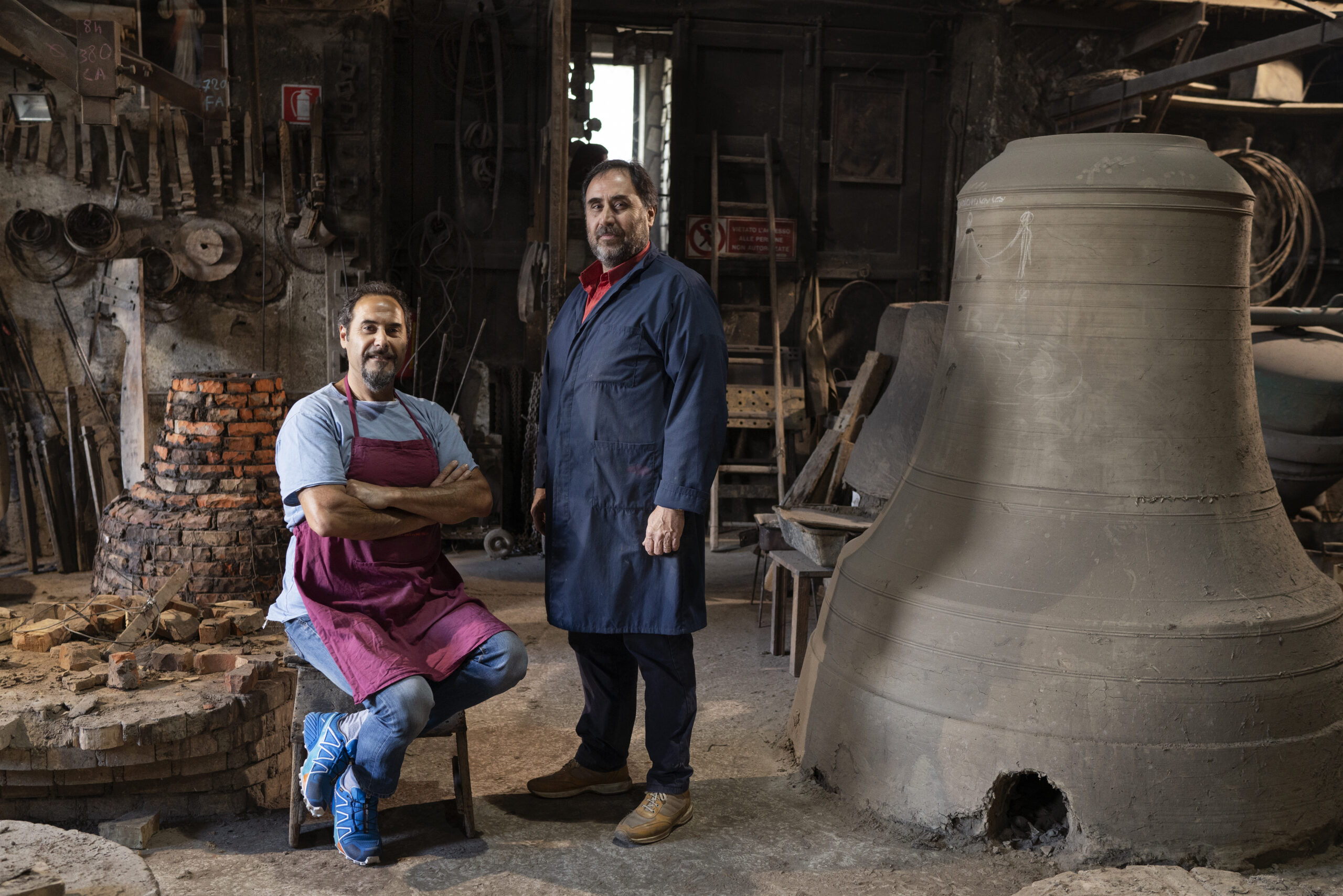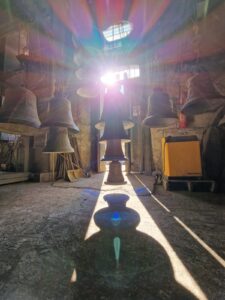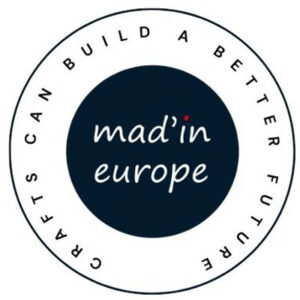This interview is part of a series of interviews with European craftspeople conducted in collaboration between FRH, the European network for religious heritage, and Mad’in Europe, the network of European fine and traditional crafts and cultural heritage restoration professions.

Pasquale and Armando Marinelli. © Campane Marinelli.
Campane Marinelli has the exceptional distinction of being the oldest bell foundry in Italy. The business of the Marinelli family has been operating in the small village of Agnone, preserving the same techniques and materials for more than 1,000 years. The foundry is run today by the brothers Armando and Pasquale Marinelli. We recently had a conversation with Armando to look back at their long history and hear about the challenges facing this centuries old craftsmanship.
1. Please introduce yourself (profession, area of expertise and years of experience).
I am Armando Marinelli and together with my brother Pasquale, I run the Marinelli Foundry. I have been in contact with the world of bell casting since I was a kid, but I got involved in a more serious manner when I was 20 years old. It was at that age, after the loss of my father, that I started working in the business, replacing him in the artistic part of the foundry while my uncle continued doing the managerial part. As time went by I also assumed the managerial part.
2. What clients/markets do you work with (are they local, national or international)? Which needs does your work generally tackle? Which are the required skills and certifications that your customers request?
Our main customers are churches, both in Italy and abroad. The relationship with the church is very important in this business. Apart from making bells, we have diversified our artistic work. We also operate the Historical Bell Museum. Approximately 30,000 visitors come come to learn more about bell casting every year. This is all part of the Marinelli family’s work.
We don’t have any special certification. Our factory has been functioning for 1,000 thousand years, so this is our certification. We take great care to ensure that all our bells have a perfect finish, out of respect for the past and the long history of our foundry. The name Marinelli is stamped on them, so we can’t afford any faults.
3. Please briefly explain how your profession is related to religious heritage and/or cultural heritage.
The bell was born as the voice of God, a connection between Earth and Heaven. It was very important for men: it rang in the morning to tell people to go to work, at noon when they had to eat and in the evening to indicate that they should go home. It accompanied the shepherds along the transhumance. If you were lost in the woods, hearing the bell could allow you to find the village again. It was also the bell that gave happy and sad news. Until not so long ago it was still used to call the people to gather. Sadly we don’t hear the bells anymore – perhaps too much noise.

Marinelli Foundry atelier. © Campane Marinelli.
4. Please describe the main steps of your usual working process and the materials that you use most.
The bell-making process is very long and complex. There are various stages and each one has its own timing. The whole process of casting a bell takes a minimum of 3 months.
The mould is made up of three fundamental parts: the core or inner mould, the false bell which is the part that will later be filled up with bronze, and the outer mould. To create the moulds, you have to start by delineating the internal shape. This is called the bell’s soul. This part is then covered with clay, creating what we call the “false bell” that will help us delineate and create the outer mould. At this stage we can use plaster to create different decorations, the name of the country, and any other detail the buyer asks for. These decorations are placed on the false bell. And then we apply more clay on the false bell to create the “mantle” or outer mould. The last step is breaking the “false bell” in between the moulds, to free the space where we will pour the bronze.
The fusion is the most important moment. The bronze is melted in an oven at about 1,200ºC and poured carefully into the mould. This is the moment to bless the bell. Preachers often come to say a prayer. In 1995 St John Paul II came to the foundry to visit the litany of his bell.
Then the bell must dry. The drying process is also very slow. The bell mustn’t be exposed to the sun. It should dry as slowly and naturally as possible because if the process is not natural, there is a risk of cracking.
In the end, we have a bell that is unique, there is no such thing as an equal copy in this business. You can make two bells with the same mould at different times and each of them will be unique.
5. Do you regularly cooperate with craft professionals from other fields? If yes, can you explain which ones and why?
The clapper that produces the sound in the bell used to be hand-forged here at the foundry, but today is forged by specialised companies. There are companies that provide us with computers so that we can digitise the bells, study the shape and give them a good finish in a simpler way. The clapper can be made of bronze, but it is usually iron because it produces a better sound.
Sometimes we also make iron bells and iron bell towers. With these, we need external help too.
 6. Please mention any innovation that helped improve your work (technological, digital, material related, legal…) and explain the impact they had on your profession.
6. Please mention any innovation that helped improve your work (technological, digital, material related, legal…) and explain the impact they had on your profession.
It may seem trivial now, but many years ago it was a problem to work out how to get a bell up the bell tower. In the old days, two mountains of sand were made to roll the bell up to the tower. Now a lorry with a crane can lift the bell up the tower in a minute. It seems so insignificant, but these are modern things that have helped us a lot.
Another important change is how we ring the bells. In the past, the bell was rung by the sacristan. Today this is done with a computer. The bell is still the same, but the movement is now made by pressing a button or by programming the times at which it must ring with devices located in the bell tower.
7. How did you learn the profession? Can you detail your learning path mentioning schools and workshops where you were trained?
The world of the Foundry is a special world, you never stop learning. My father was a life coach for me and my brother. We walked this path together. I have always said that in life you gain experience with the sum of the mistakes you make. The more mistakes, the more experience you gain.
I went to technical college which helped me a lot. When I was a kid I used to play at the foundry. It was a bit of a nuisance for our parents, but also part of the Marinelli family DNA. As time went by, the game became a reality and I found myself making bells.
If someone asks from 1 to 1,000 how much have you learned, a bell caster can answer: “I know how to do everything, I understand everything”. And here comes the magic of bell casting, because you may think you’ve learnt everything but then one day comes a failure and you see you have not learnt everything. The only way to move forward is to learn day by day, make mistakes, understand and move on.
8. Do you pass on your knowledge to young people? If yes, how? In schools, through workshops…?
We always have visitors who come to the foundry moved by the curiosity of our activities. Our museum is an important part of the foundry and we see that visitors are fortunately increasing more and more. Some of them are very knowledgeable and they really want to understand more about bell casting, and how our foundry and the way of working has survived so long.
We have realised that there is an important part missing in educational institutions: more attention to manual skills. Making children and young people understand that not everything is sitting in front of a computer, but they can use their hands to create extraordinary things. Now that everything is changing this seems like an important mission
9. What would you recommend to a young person interested in your profession? What are the opportunities and areas in which they can work with your skills?
This is a complicated question. For young people, those entering the labour market today, the future is very uncertain. I have one son who is 30, another who is 27 and the third who is 18. The third one asked me once: “What should I do in the future? I would like to do architecture, but I need 6 years for that, and what will architecture be in 6 years?”. It is very painful for parents to see this situation.
For our children, it is difficult for crafts or any creative craft activity to be taken into serious consideration as a career path. Young people out there are pursuing a profession related to their qualifications and it is a bit difficult to go back and do a job that does not give them the satisfaction of working in what they have studied.
View this post on Instagram
10. What are the threats that may endanger your profession? Can you mention some difficulties that are associated with your work? Which could be the solutions to better support your profession and preserve the transmission of skills?
When we were kids, our parents feared that bells would no longer be made. Not because we were no longer making them, but because bells were no longer needed or linked to the church. Let’s say that we are in a sense like a thermometer of faith: the more bells are made closer to the church closer to religion and Christianity we are.
Another problem is the time of production the customer wants. The job used to be done with more serenity. But times are accelerating and our job mirrors that acceleration, especially in our relationship with our customers. They want to have a bell right away, but we have no possibility of making the bells quickly. We dedicate a lot of time to Public Relations and increasing the relationship with the customers. We manage to make them understand how we do our work and why the process needs a certain time. Because this is what defines us, time should not be the most important factor in this business.
Except for the new needs in the relationship with the customers, our work has remained the same for a thousand years. Nothing has changed in terms of techniques and materials. We are tied to 1,000 years of history, and we do not want to break with this tradition. Perhaps this is what makes us modern today, trying to preserve this link with the past.
You can find out more about Campane Marinelli’s work on their website, as well as on Facebook, Instagram and YouTube.
 Mad’in Europe (MIE) is a small company committed to promoting craft professionals and crafts professions and to supporting the transmission of crafts skills at a European level. Its multilingual portal gathers a large audience around the profiles of 1,500 crafts, restorers and fine crafts professionals. As a member of some European organizations and thanks to its wide European network MIE participates in several transversal activities including Erasmus and Horizon projects which focus on valorisation of crafts, preservation of traditional know-how, and raising awareness among young people, for whom the sector represents a source of employment.
Mad’in Europe (MIE) is a small company committed to promoting craft professionals and crafts professions and to supporting the transmission of crafts skills at a European level. Its multilingual portal gathers a large audience around the profiles of 1,500 crafts, restorers and fine crafts professionals. As a member of some European organizations and thanks to its wide European network MIE participates in several transversal activities including Erasmus and Horizon projects which focus on valorisation of crafts, preservation of traditional know-how, and raising awareness among young people, for whom the sector represents a source of employment.
 Future for Religious Heritage (FRH) is an independent, non-faith, non-profit European network founded in 2011 and based in Brussels to promote, encourage and support the safeguard, maintenance, conservation, restoration, accessibility and embellishment of historic places of worship. Our network represents more than 80 organisations and over 120 professionals from 36 countries, which includes NGOs, governmental organisations, religious and university departments, and individuals. We are one of the 36 European networks currently supported by the Creative Europe Networks programme.
Future for Religious Heritage (FRH) is an independent, non-faith, non-profit European network founded in 2011 and based in Brussels to promote, encourage and support the safeguard, maintenance, conservation, restoration, accessibility and embellishment of historic places of worship. Our network represents more than 80 organisations and over 120 professionals from 36 countries, which includes NGOs, governmental organisations, religious and university departments, and individuals. We are one of the 36 European networks currently supported by the Creative Europe Networks programme.





Follow us: